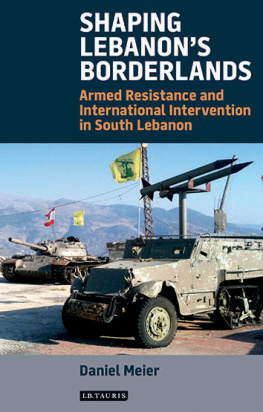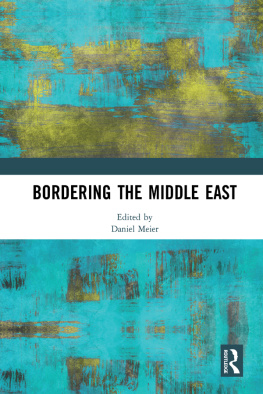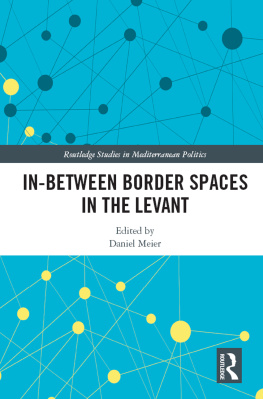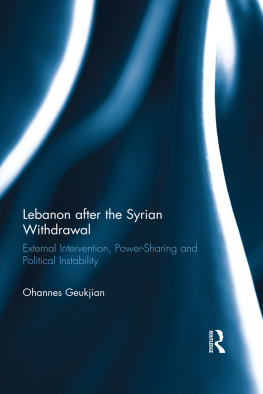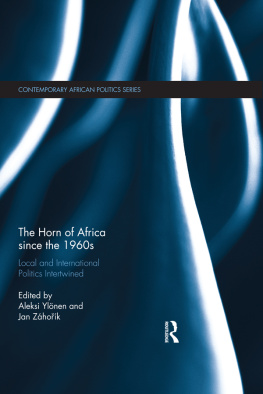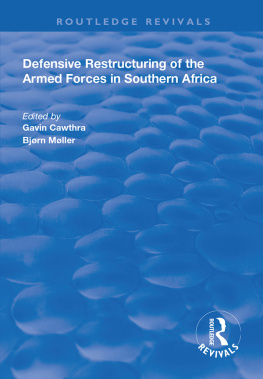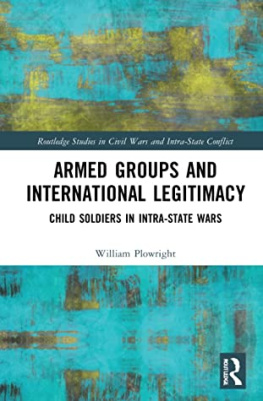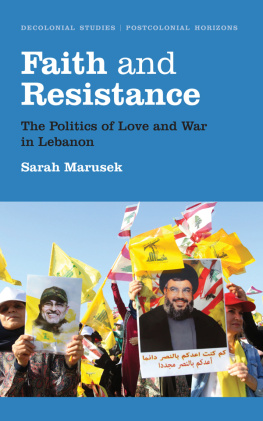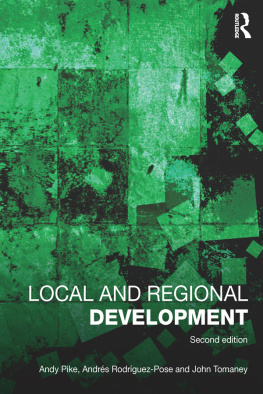Daniel Meier is a research fellow at CNRS in Grenoble and was Senior Associate Member at St Antony's College, Oxford University. He holds a PhD in Development Studies from the Graduate Institute of International and Development Studies (IHEID) and teaches at the University of Geneva.
Shaping Lebanon's Borderlands examines a tiny patch of the earth's surface but one of immense contemporary significance. This is the borderland of Southern Lebanon that unmarked boundary between Israel, Lebanon, and Syria. Meier draws upon his deep understanding of PalestinianLebanese relationships to inform this intelligent and intriguing study of the political relationships between space and identity in the limited territory of Southern Lebanon. This book is of tremendous importance in understanding the complex relationships of the Lebanese people with four major actors: Palestinian refugees in Lebanon; Hizbollah; the UN military presence in the area (UNIFIL); and the Lebanese state. These relationships and the nature of bordering will become critically important to understanding the post-Arab Uprising era to come.
Dawn Chatty, Emeritus Professor of Anthropology and Forced Migration, Oxford University
A comprehensive study on a region that, since the 1970s, has been the most volatile frontline of the ArabIsraeli conflict. It is essential reading not only for students of the modern Middle East but also for those who are interested in border dynamics worldwide, in militant non-state actors and in identity construction in conflict zones.
Asher Kaufman, Professor of History and Peace Studies, Kroc Institute for International Peace Studies, University of Notre Dame
Reading Shaping Lebanon's Borderlands was like navigating uncharted waters. Spatial issues, as inextricably linked with sovereignty and national self-understanding, are analysed in a new light. The book eloquently recapitulates how various narratives were constructed.
Tarek Mitri, Director of The Issam Fares Institute for Public Policy and International Affairs, American University of Beirut
SHAPING
LEBANON'S
BORDERLANDS
Armed Resistance and International Intervention in South Lebanon
D STHER M ANIEL
In the memory of my father
Published in 2016 by
I.B.Tauris & Co. Ltd
London New York
www.ibtauris.com
Copyright 2016 Daniel Meier
The right of Daniel Meier to be identified as the author of this work has been asserted by the author in accordance with the Copyright, Designs and Patents Act 1988.
All rights reserved. Except for brief quotations in a review, this book, or any part thereof, may not be reproduced, stored in or introduced into a retrieval system, or transmitted, in any form or by any means, electronic, mechanical, photocopying, recording or otherwise, without the prior written permission of the publisher.
Every attempt has been made to gain permission for the use of the images in this book. Any omissions will be rectified in future editions.
References to websites were correct at the time of writing.
Library of Modern Middle East Studies 176
ISBN: 978 1 78453 253 6
eISBN: 978 1 78672 057 3
ePDF: 978 1 78673 057 2
A full CIP record for this book is available from the British Library
A full CIP record is available from the Library of Congress
Library of Congress Catalog Card Number: available
LIST OF ILLUSTRATIONS
Figures
Glory to the heroes of Beaufort Castle, symbol of LebanesePalestinian steadfastness
Down in the Abyss, an Israeli tank as fragile as a spider's web (beit al-anqabt). Mleeta museum, 2012.
Maps
The lines that have shaped South Lebanon (191676)
The emergence of the Palestinian resistance in South Lebanon
Development of the security belt in South Lebanon (197678)
The 1982 Israeli occupation and steps of withdrawal from Lebanon (19822000)
Lebanese reservations about the Blue Line
Lebanon's EEZ delineation and the contested zone
Table
Description of LAF reservations about the Blue Line
LIST OF ABBREVIATIONS
| ADF | Arab Deterrent Force |
| AFL | Army of Free Lebanon |
| ANM | Arab Nationalist Movement |
| DFLP | Democratic Front for the Liberation of Palestine |
| EEZ | exclusive economic zone |
| EU | European Union |
| FAI | Fdration Aronautique Internationale |
| FPM | Free Patriotic Movement |
| ICRC | International Committee of the Red Cross |
| IDF | Israel Defense Forces |
| IS | Islamic State |
| ISF | Internal Security Forces |
| JGIS | Joint Geographic Information Service |
| LAA | Lebanese Association for the Arts |
| LAF | Lebanese Armed Forces |
| LCP | Lebanese Communist Party |
| LNG | liquefied natural gas |
| LNM | Lebanese National Movement |
| LNRF | Lebanese National Resistance Front |
| NGO | non-governmental organisation |
| OACL | Organisation de l'Action Communiste au Liban (Communist Action Organization in Lebanon) |
| OETA | Occupied Enemy Territory Administration |
| OPT | Occupied Palestinian Territories |
| PA | Palestinian Authority |
| PEF | Palestine Exploration Fund |
| PFLP | Popular Front for the Liberation of Palestine |
| PFLP-GC | Popular Front for the Liberation of Palestine General Command |
| PLA | Palestine Liberation Army |
| PLF | Palestine Liberation Front |
| PLO | Palestine Liberation Organization |
| PSP | Progressive Socialist Party |
| SDN | Socit des Nations (League of Nations) |
| SLA | South Lebanese Army |
| SPP | Syrian Popular Party |
| SSNP | Syrian Social Nationalist Party |
| TF | Technical fence |
| UAV | unmanned aerial vehicle (drone) |
| UN | United Nations |
| UNCLOS | United Nations Convention on the Law of the Sea |
| UNIFIL | United Nations Interim Force in Lebanon |
| UNRWA | United Nations Relief and Works Agency (for Palestine Refugees) |
| UNSCR | United Nations Security Council resolution |
| US | United States |
| USAID | United States Agency for International Development |
| USSR | Union of Soviet Socialist Republics |
NOTE ON TRANSLITERATION
This book uses the Arabic transliteration guide of the International Journal of Middle Eastern Studies (IJMES), with simplified diacritics. Names and places that have a common English spelling (e.g. Shebaa Farms, Rafic Hariri) will be written accordingly, without diacritics.
ACKNOWLEDGEMENTS
A book is always a long and collective process of knowledge construction, and this particular publication serves as a good example. My postdoctoral research project was shaped by a period of reflection in 200809. During this time, the Graduate Institute in Geneva and the University of Geneva's Faculty of Humanities were really helpful and my students supportive while I shaped a research programme bridging borders/boundaries and identity issues in Lebanon. My warm thanks go to Professors Riccardo Bocco and Silvia Naef for their encouragement and constant support. I left for Lebanon thanks to a postdoctoral fellowship from the Agence Universitaire de la Francophonie that allowed me to start new fieldwork. I was fortunate to receive the support of the Swiss National Science Foundation (SNF), although its intermittent funding forced me to improve my research design and expand my knowledge through literature. I am also thankful to the Institut Franais du Proche-Orient (IFPO) and the CEMAM at the Universit Saint-Joseph for hosting me during the two years I spent in Lebanon. May Myriam Catusse, Elisabeth Longuenesse, Franck Mermier and Christophe Varin find in these lines my utmost esteem. My greatest debt goes to all those I met during my research: Lebanese borderlanders, Palestinian refugees, former fighters, people in Mleeta, those working at NGOs, researchers, journalists, military officers, Lebanese and Palestinian officials and several UN troops as well as political officers in Beirut and Naqoura. Thank you so much for taking some time to answer my questions, guide me and sometimes care for my safety. It was an unforgettable human experience.

